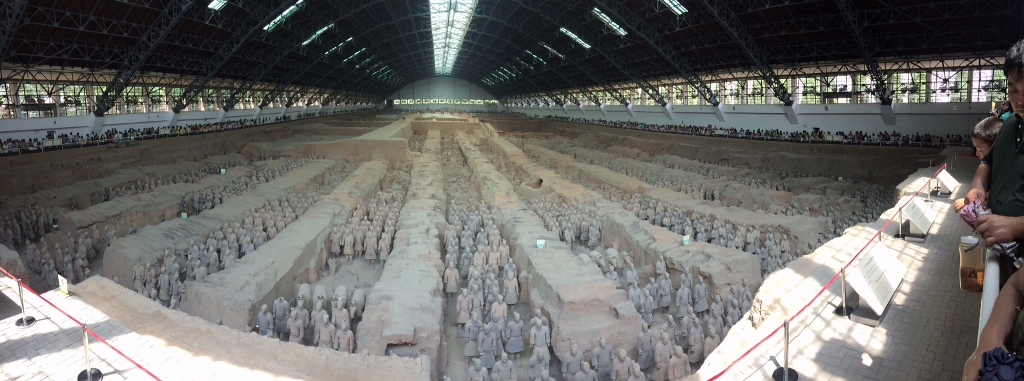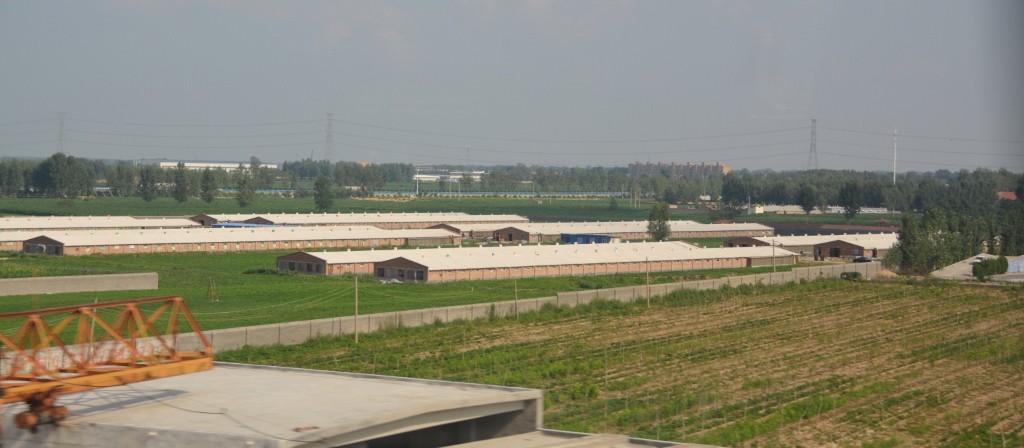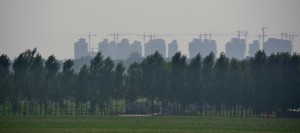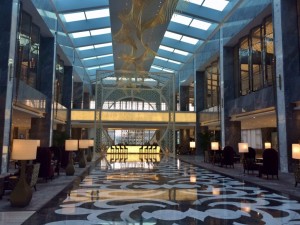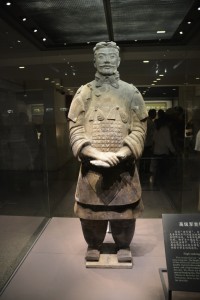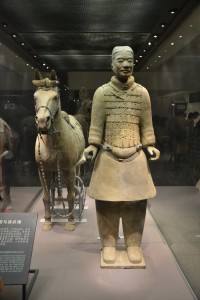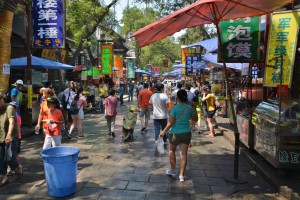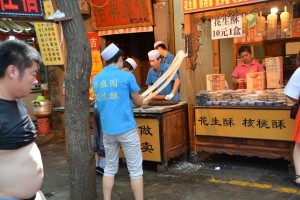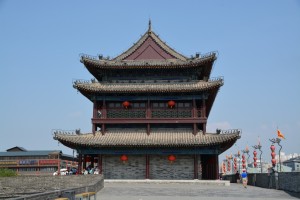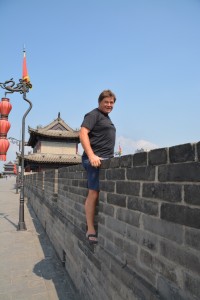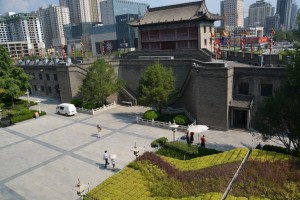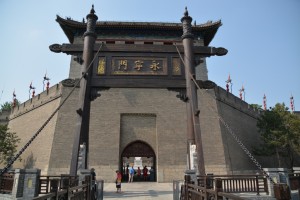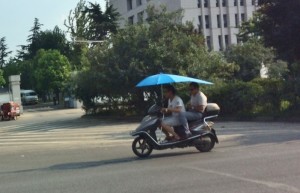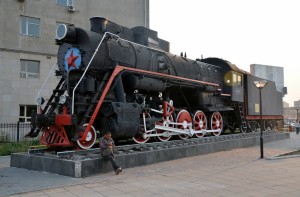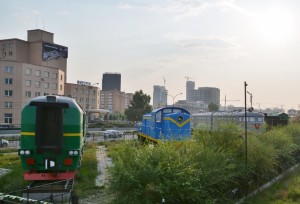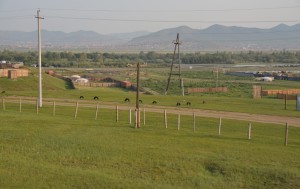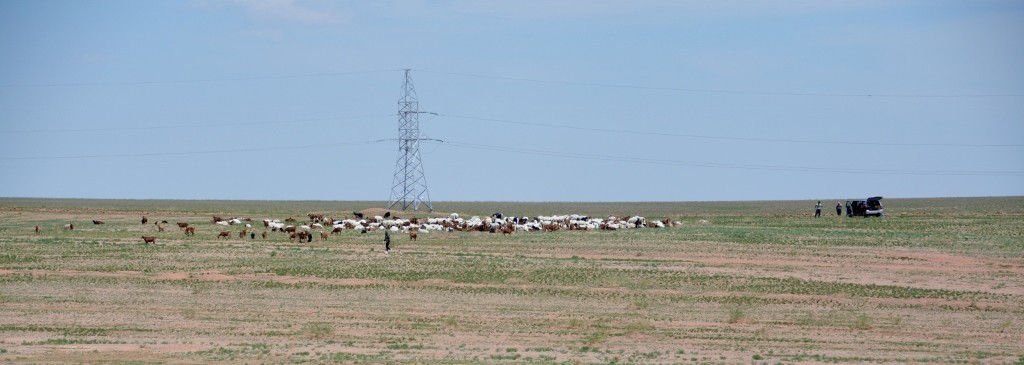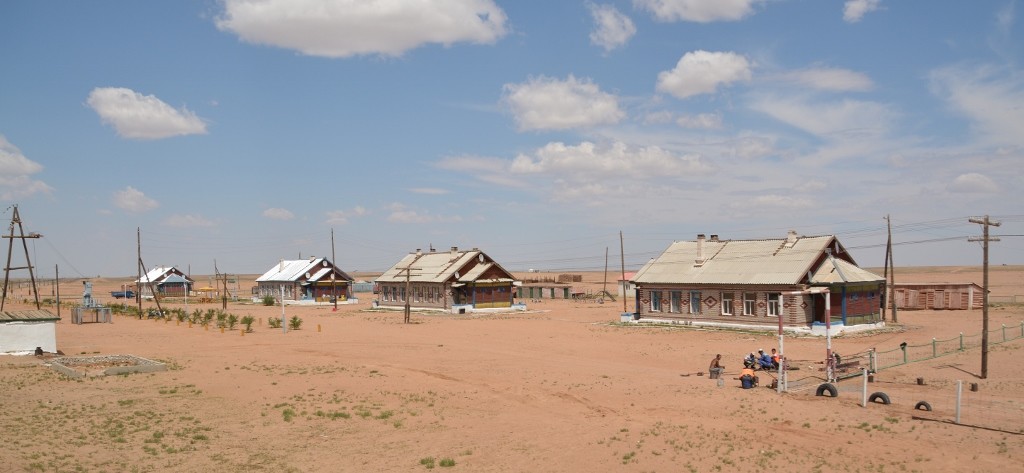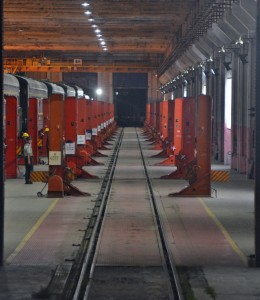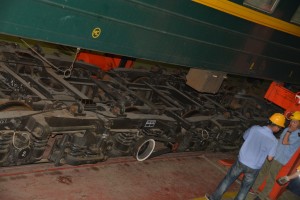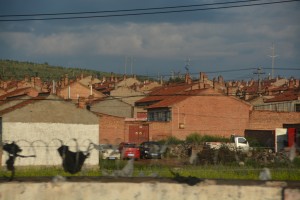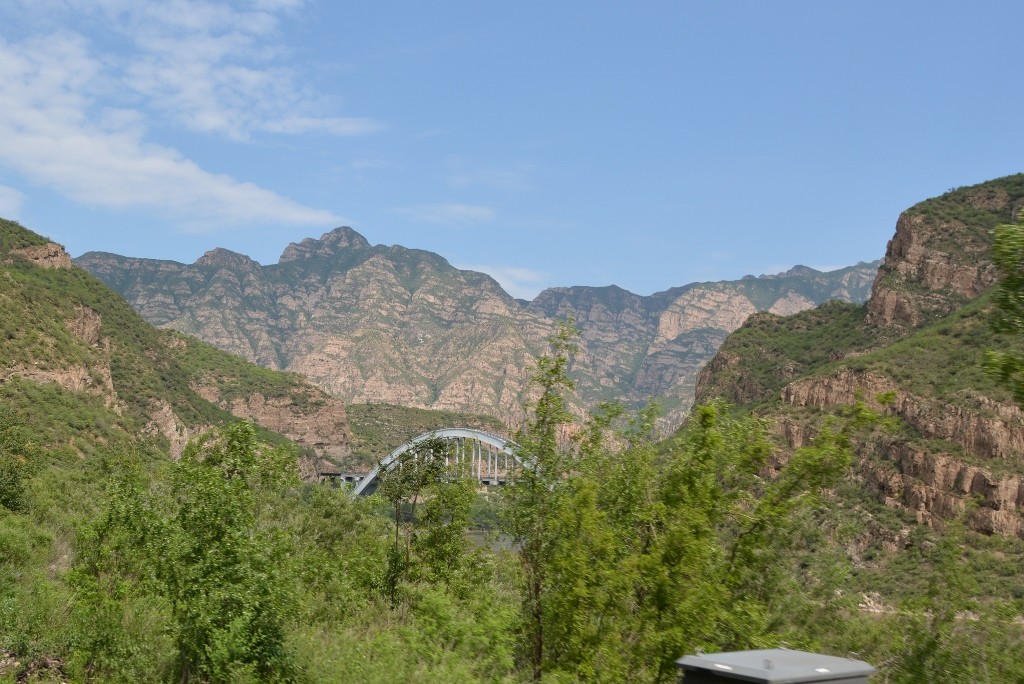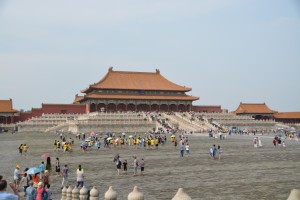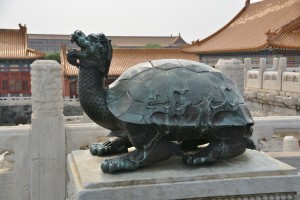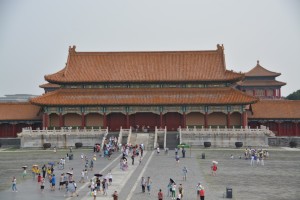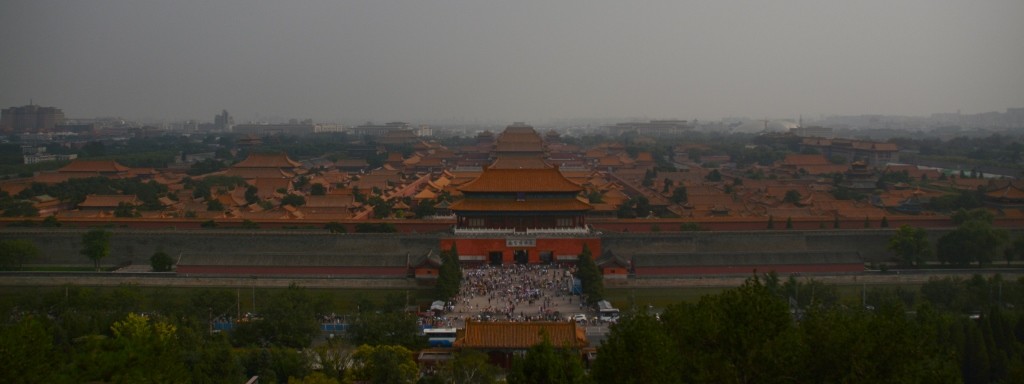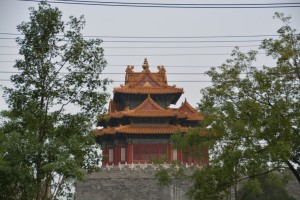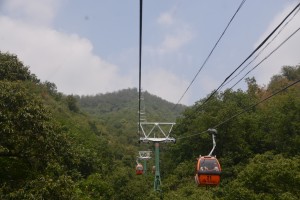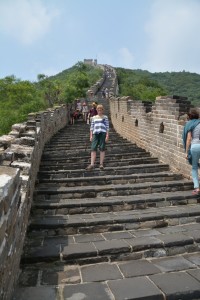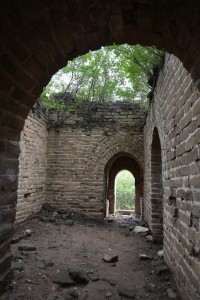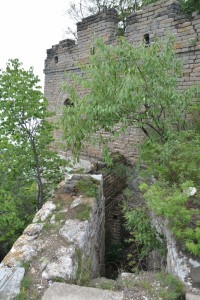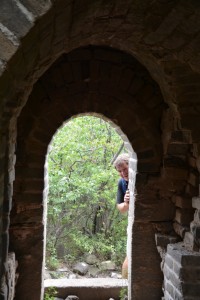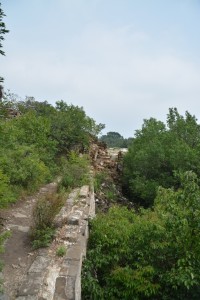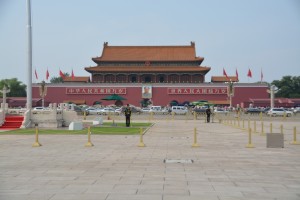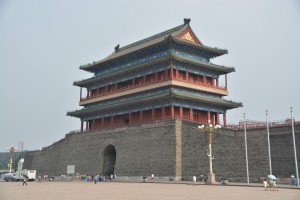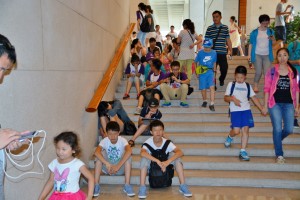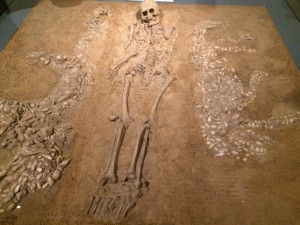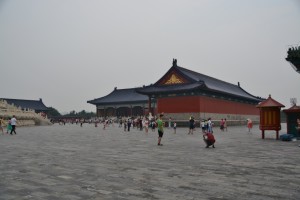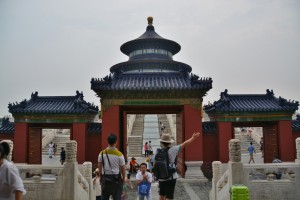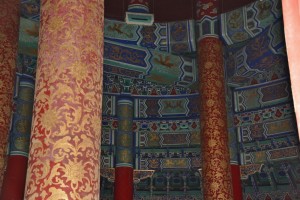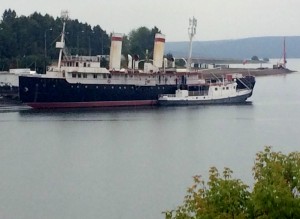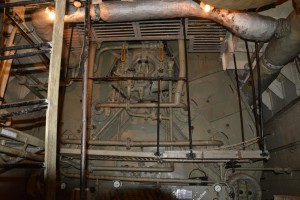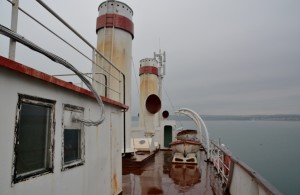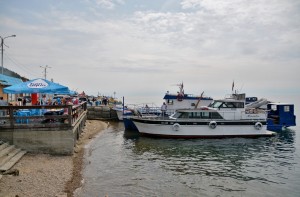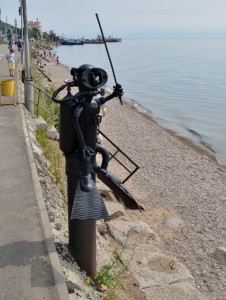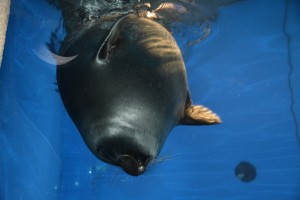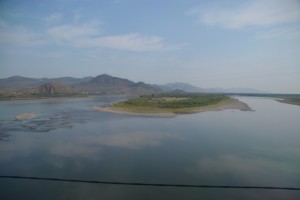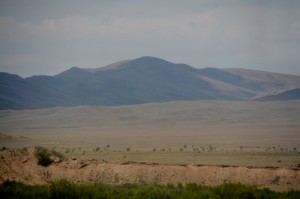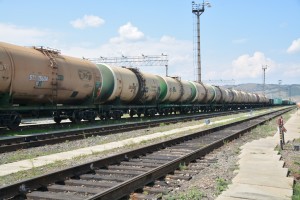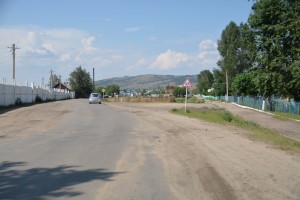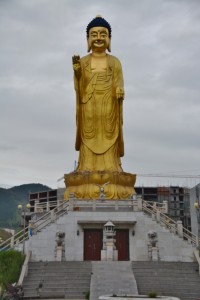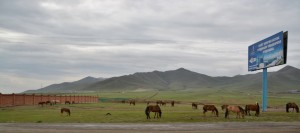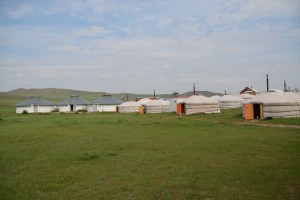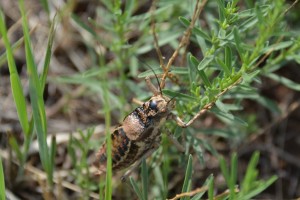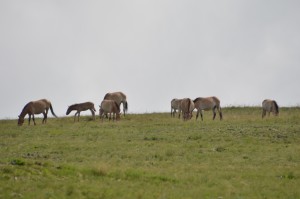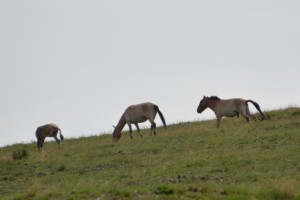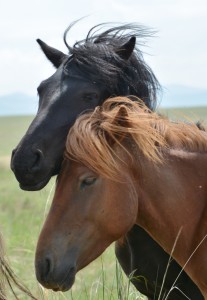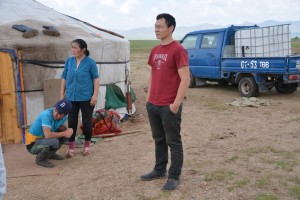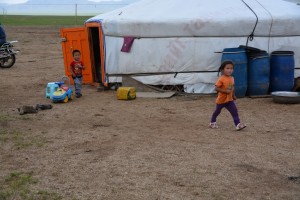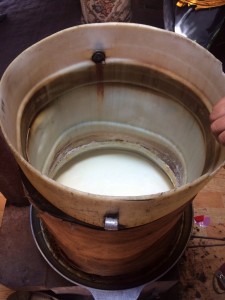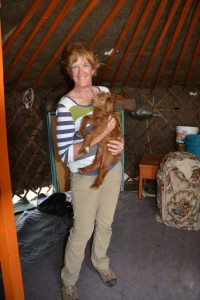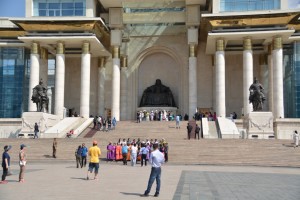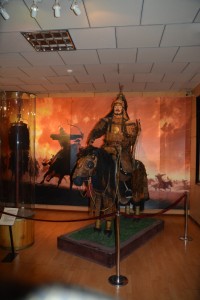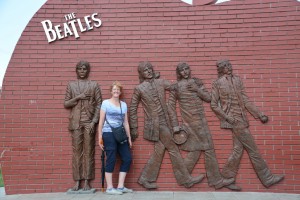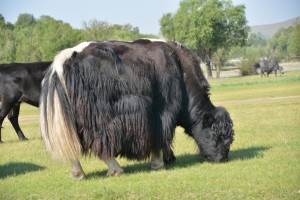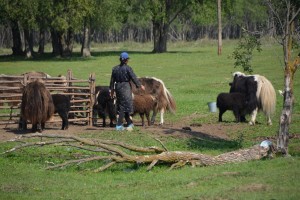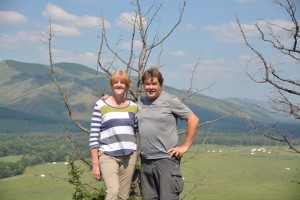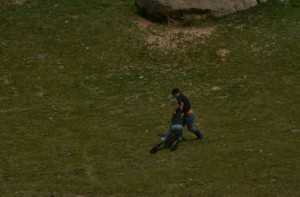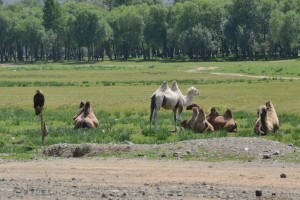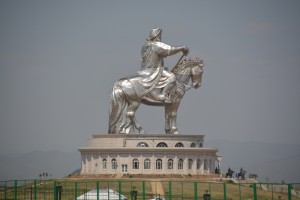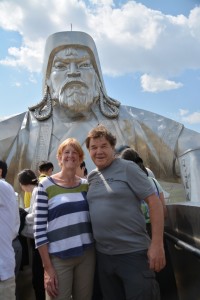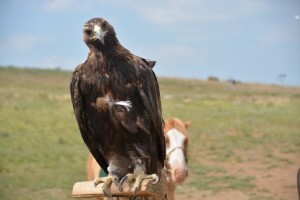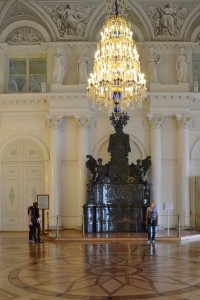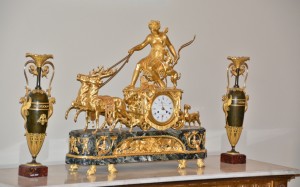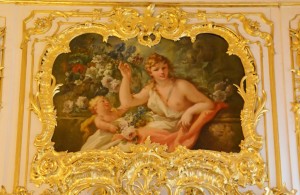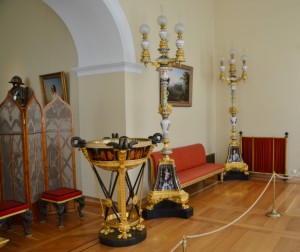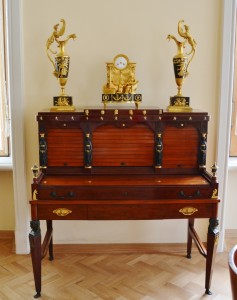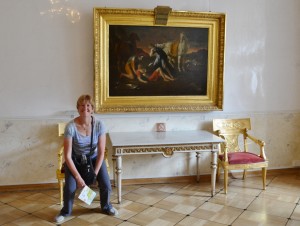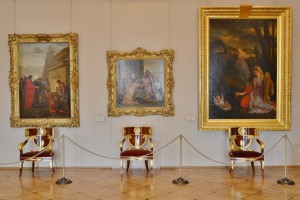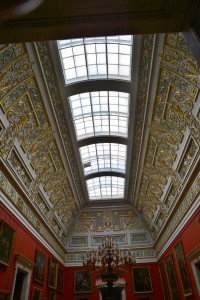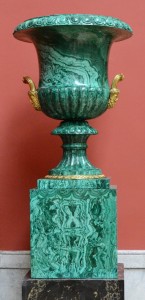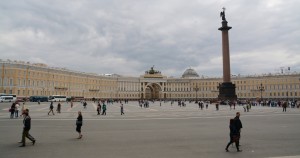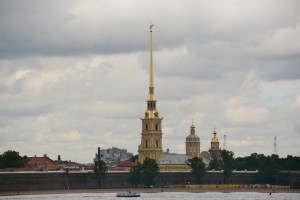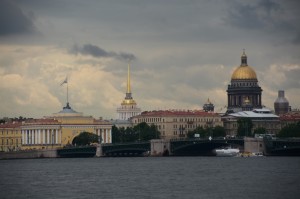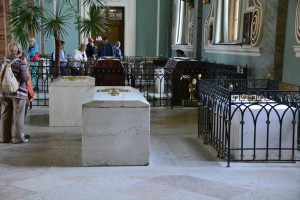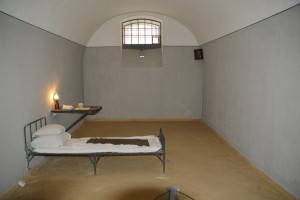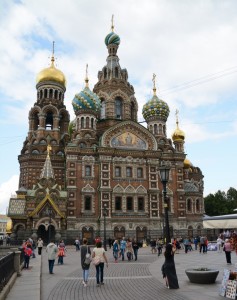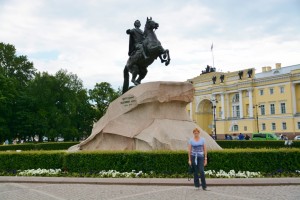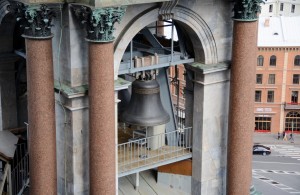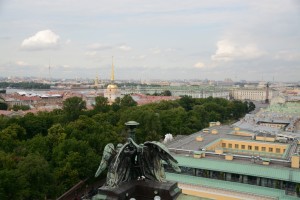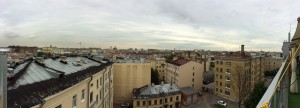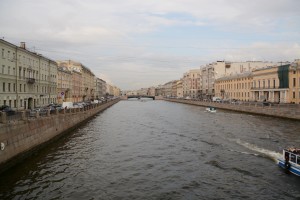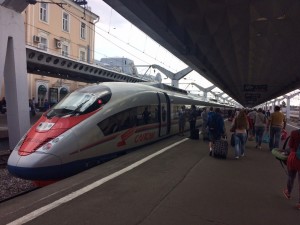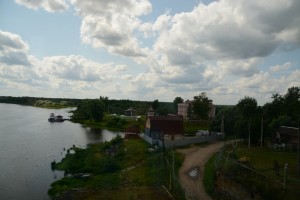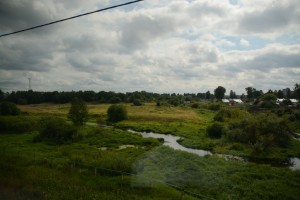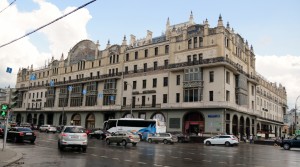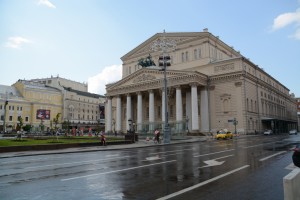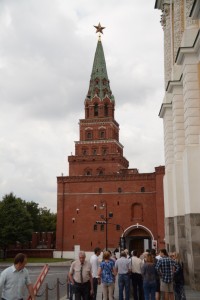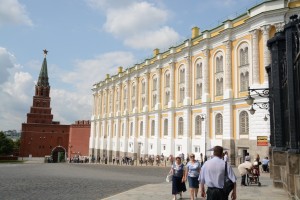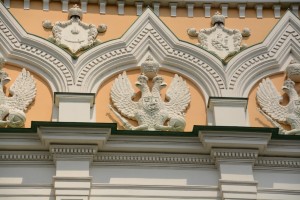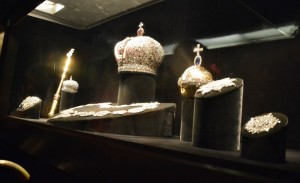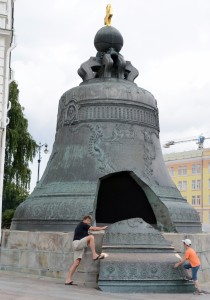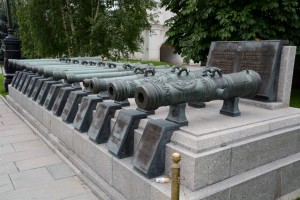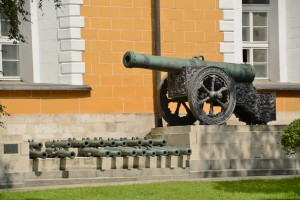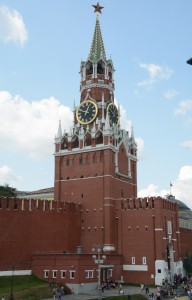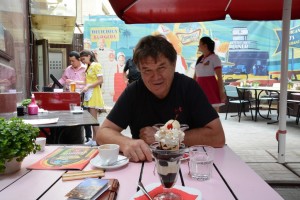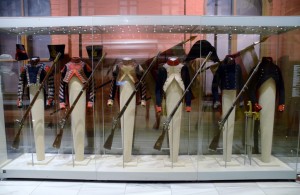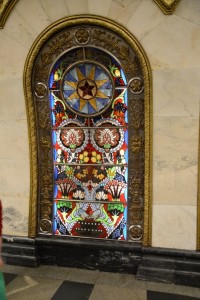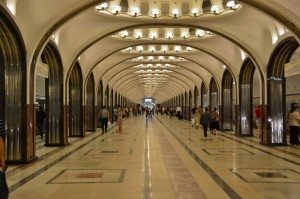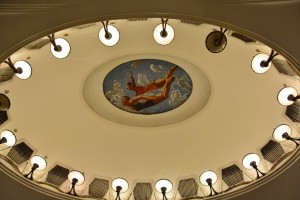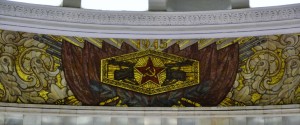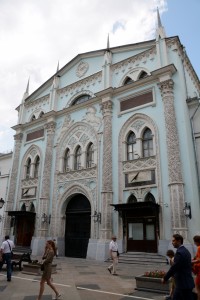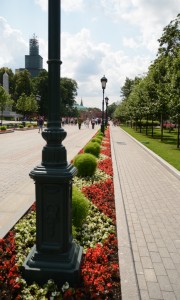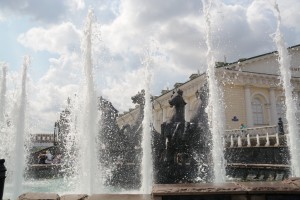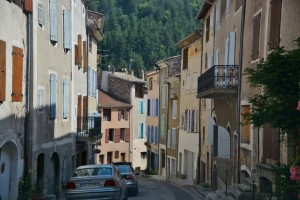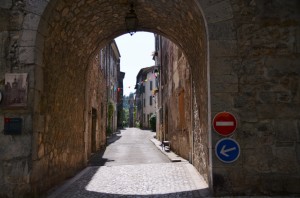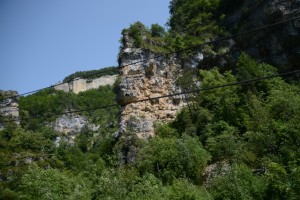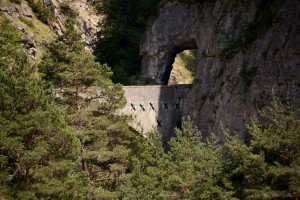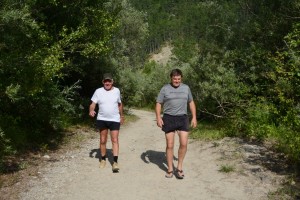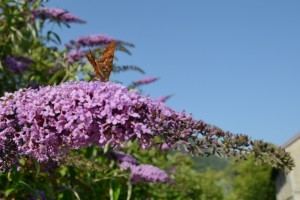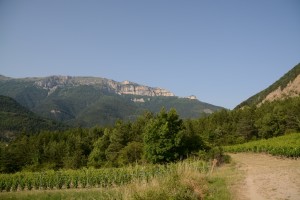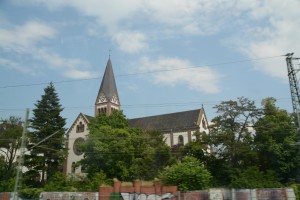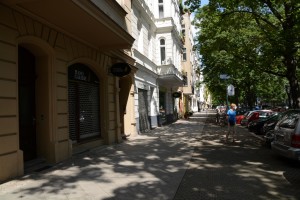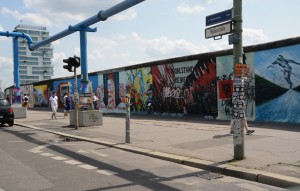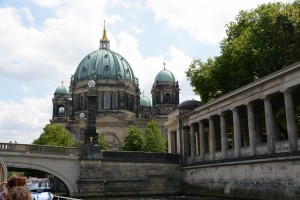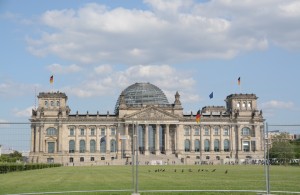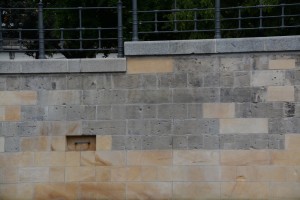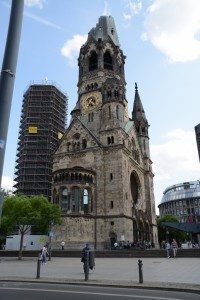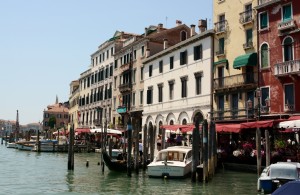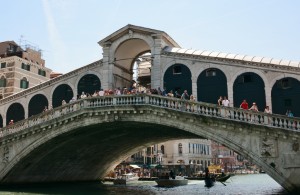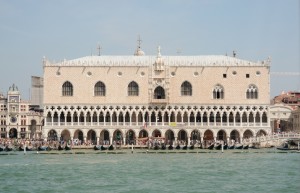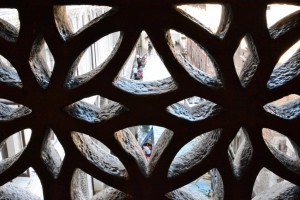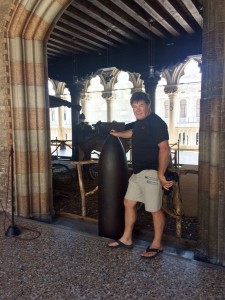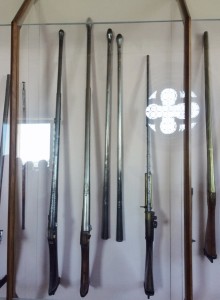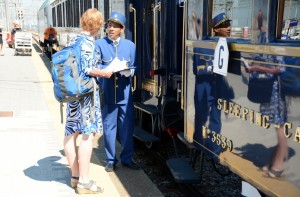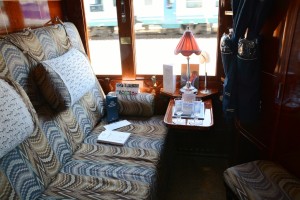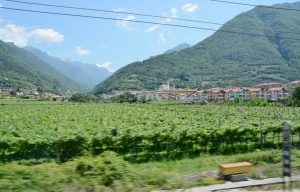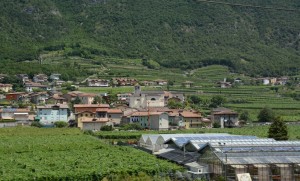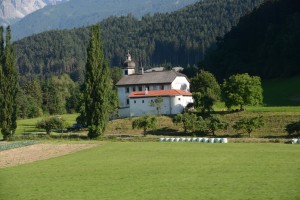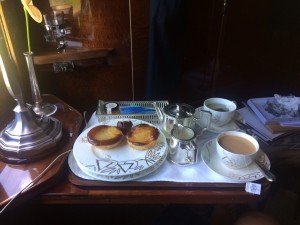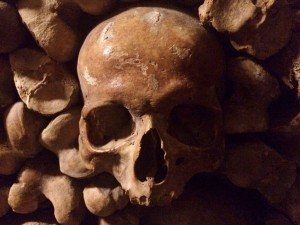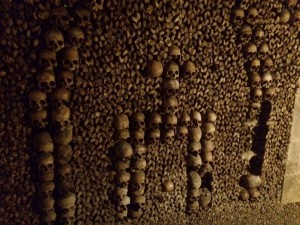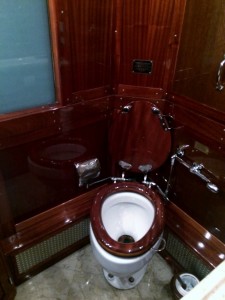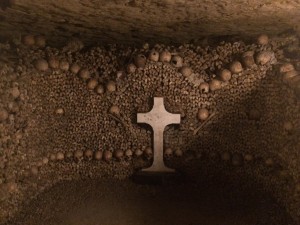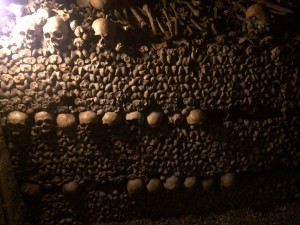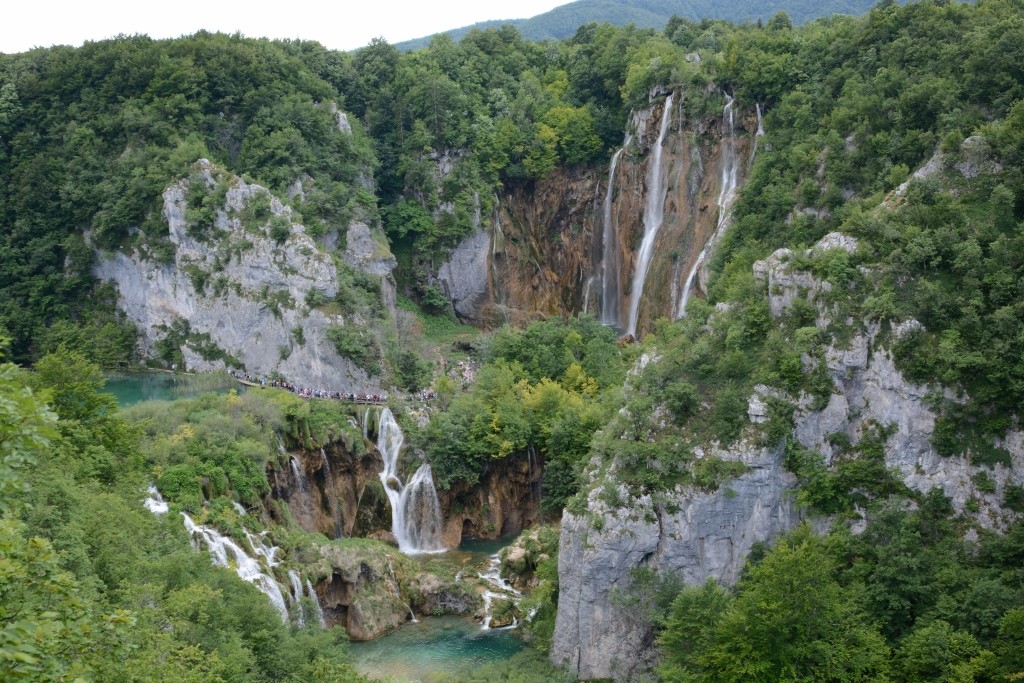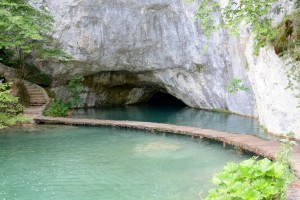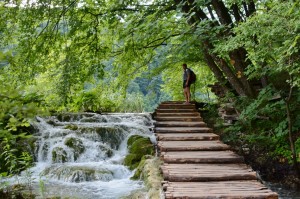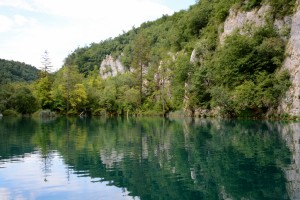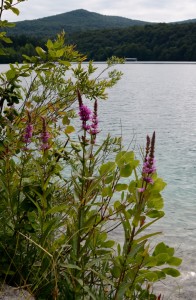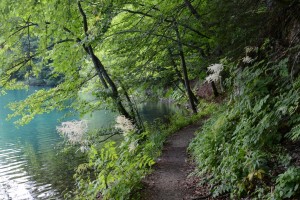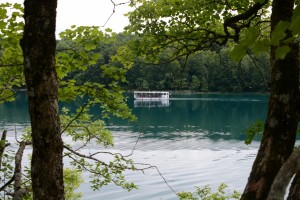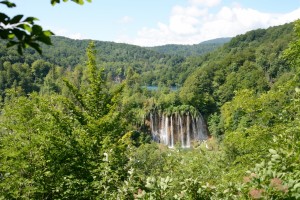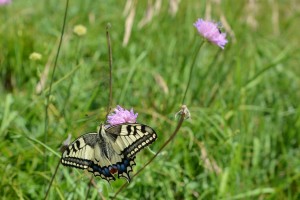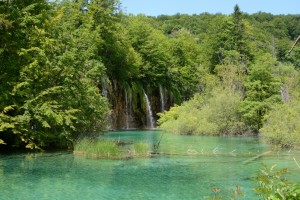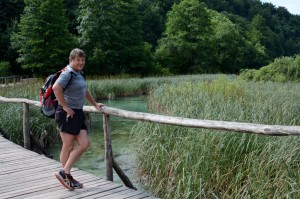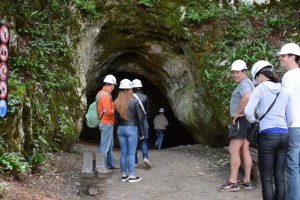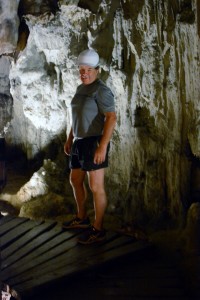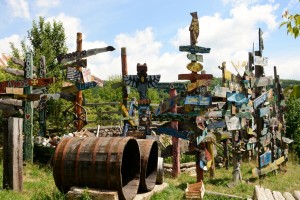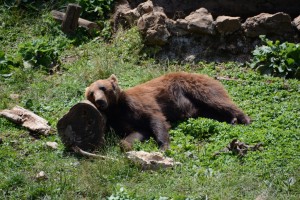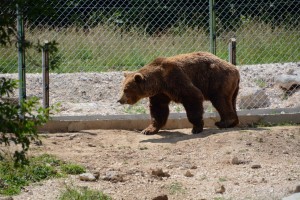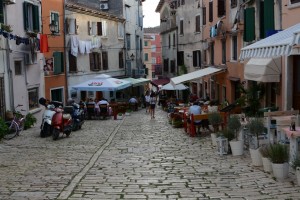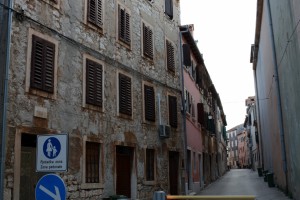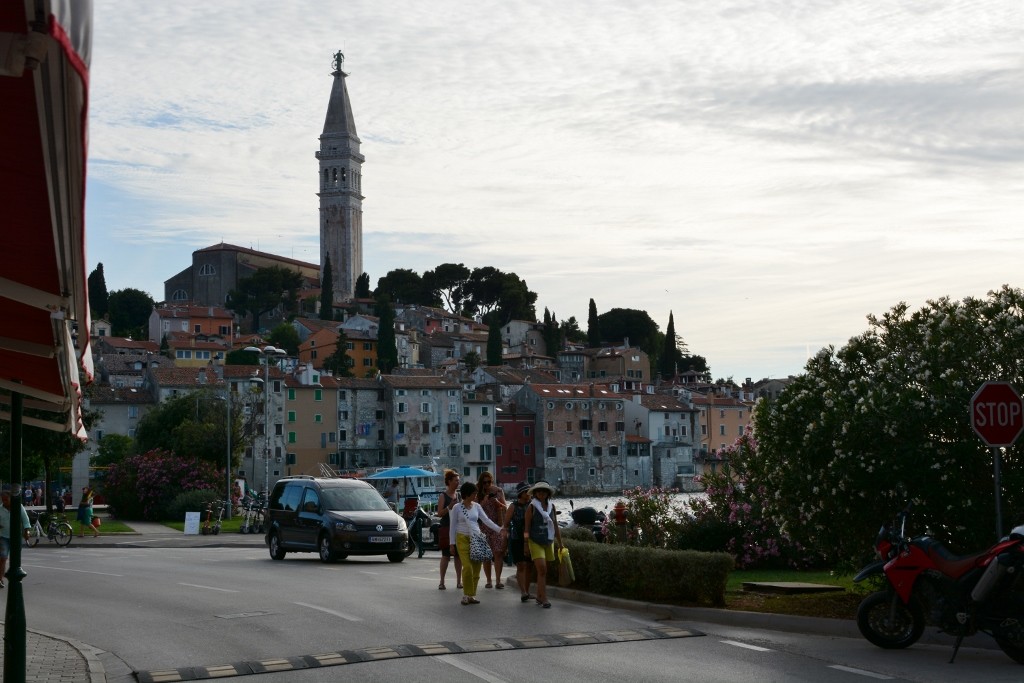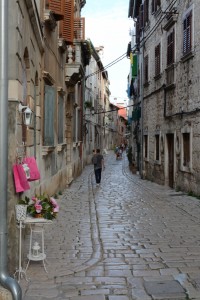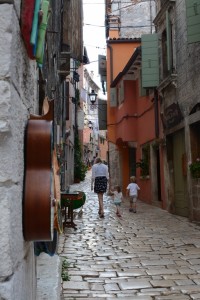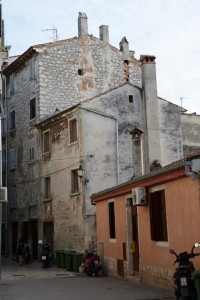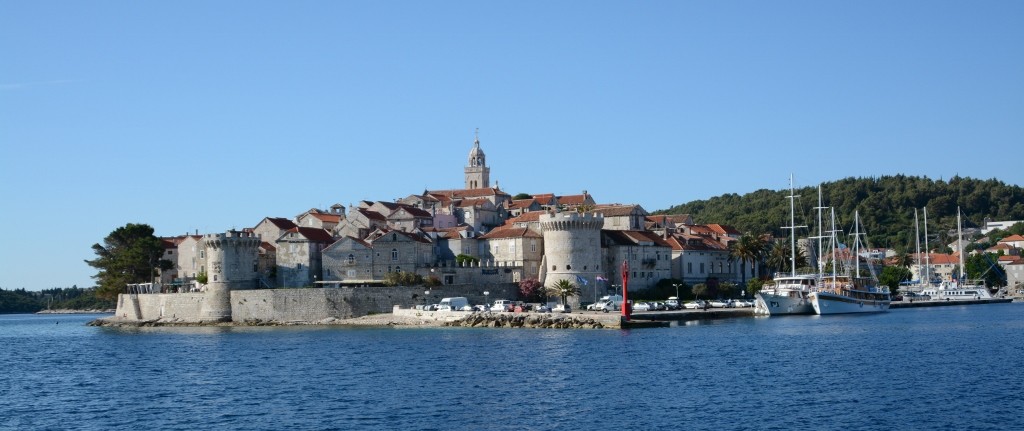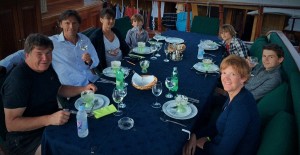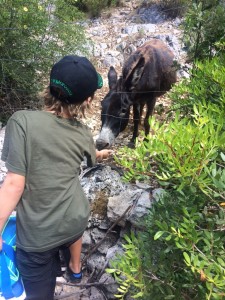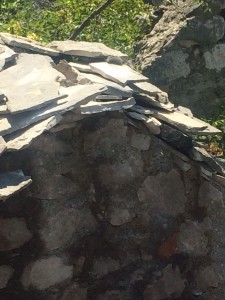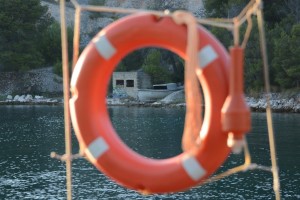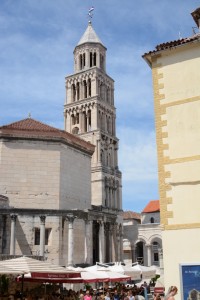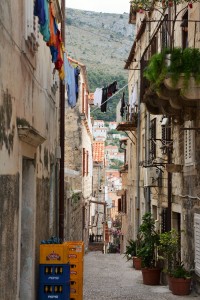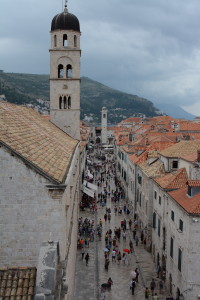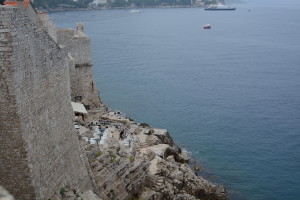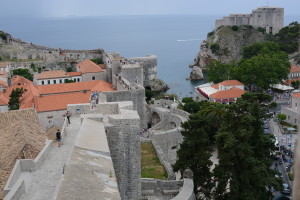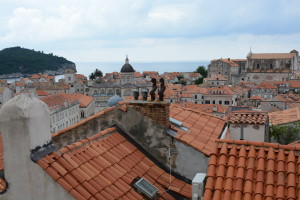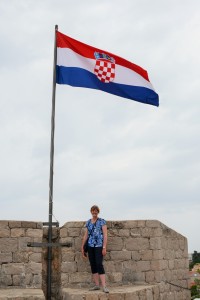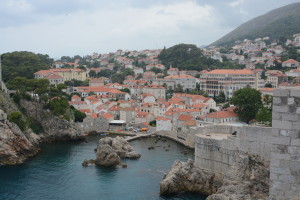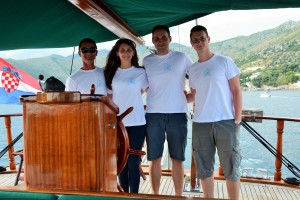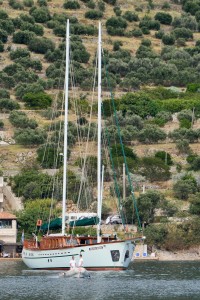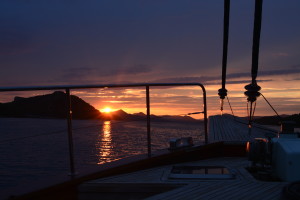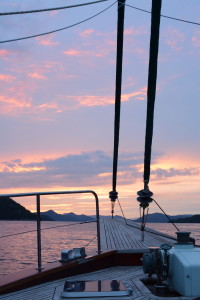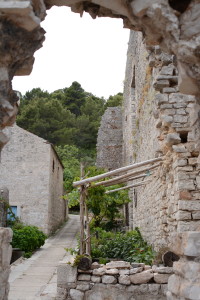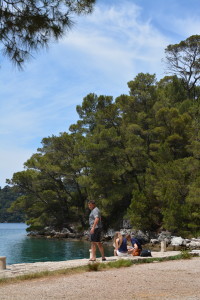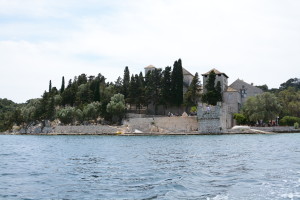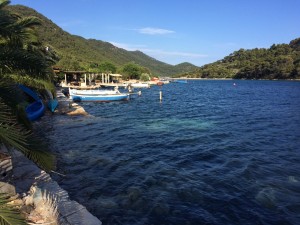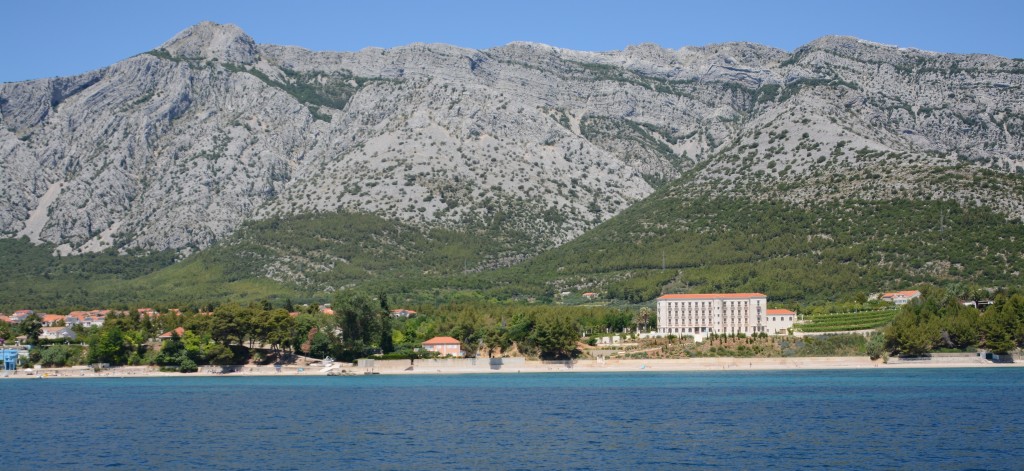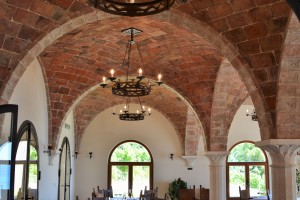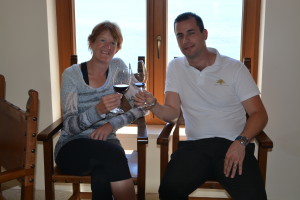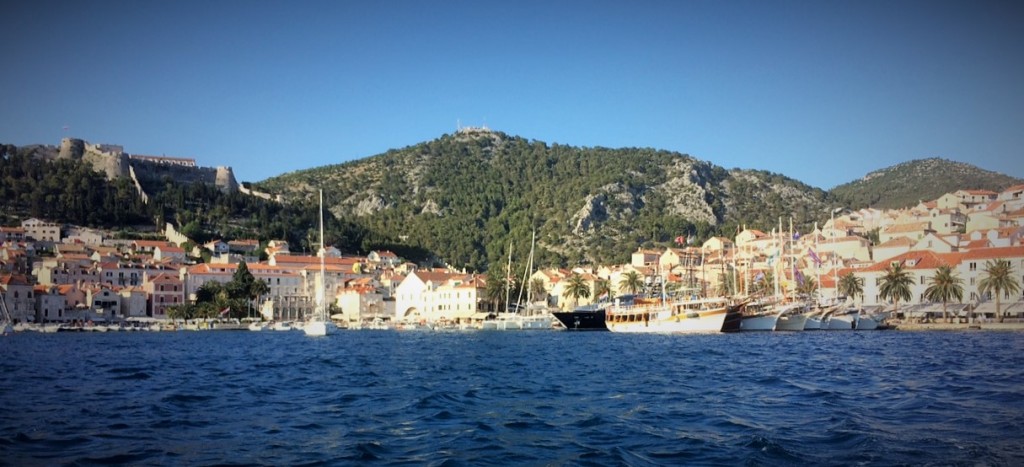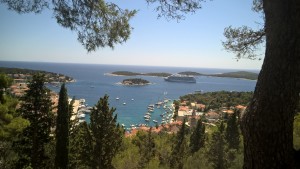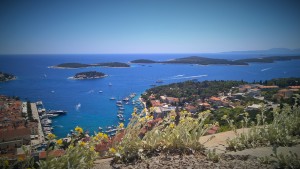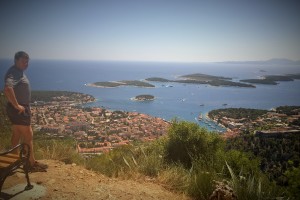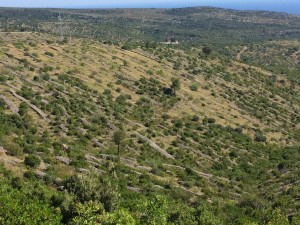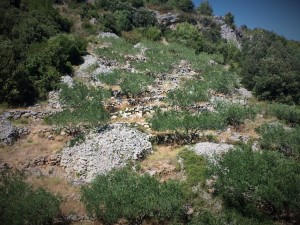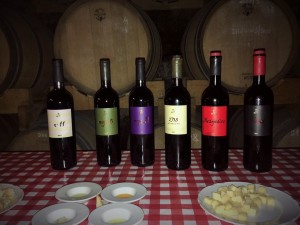Sylvia:
Saturday 11 July
After another lavish breakfast, which for Roger again included champagne and caviar, we headed off in separate directions. I had forgotten to collect our tickets for the Trans-Siberian railway and had to find my way by metro across Moscow to a guard station to pick them up. Of course, at the first metro station I went to with my route all planned out (it is not that easy to find your way around with all the stations marked in the Cyrillic alphabet which I never learned before I came, despite my good intentions) I discovered that one of the main lines I had planned to use was closed for the day for construction work! No matter, I quickly recalculated and managed to collect the tickets without too much fuss.
In the meantime Roger had decided to visit Lenin’s mausoleum in the Red Square (it is closed Fridays so we were unable to see it yesterday). Getting there 45 minutes early he went for a stroll around the square, examining the new building we referred to in yesterday’s blog and some similar buildings behind the square. His conclusion – if you want to build something to last built it out of real stone, not look-alike.

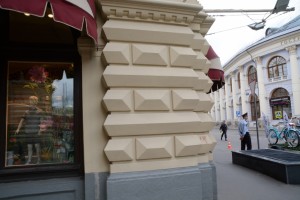
We had read yesterday that there used to be huge queues to visit Lenin but that these days there were few visitors, Roger was surprised to find an hour-long queue at 9:50am when he made it to the entrance area. Entering the tomb the young guys in front of him were told to remove their hats and get their hands out of their pockets. Descending down a large staircase, he turned to the right where the glass coffin is raised about 2m above the floor with a staircase ascending alongside it to a platform and then down the other side. He reported that to his surprise Lenin appeared to be a tiny chap in comparison to the many statues depicting him around Moscow and St Petersburg. The story goes that his body is preserved in a special fluid that is changed every 2 years to keep him, complete with moustache and goatee in place. Maybe the preservative shrunk him – or did they make the statues too big? There is also some debate as to whether the body is in fact made of wax. This is Russia – who knows? Behind the mausoleum are buried many other post-revolution Russian leaders including Stalin and Brezhnev.


Anyway, he eventually made it back to the hotel about 10 minutes after me and just in time for us to check out and make our transfer to the Yaroslavsky station. We had been advised to arrive at the station at least an hour early to allow time for security etc but security was quick and efficient which just meant we had a lot of waiting time. Roger did a bit of hunter-gathering to ensure we had provisions for our trip while I watched the bags.

Eventually we boarded our train – greeted by our provodnitsa (Roger calls her the hostie chick). Our cabin is remarkably spacious with two seats that fold down into beds and a table. We have a door that locks and toilet facilities at the end of the carriage. There is a dining car a few carriages down and several people come past offering snacks, souvenirs etc. A few hours in we receive a carbohydrate heavy snack.

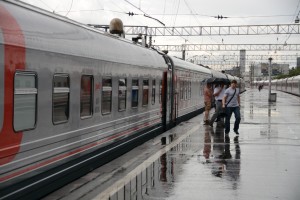

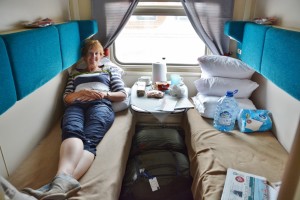
Unfortunately I was feeling very unwell so slept the first 2 hours or so and woke feeling much better. Roger had been enjoying the scenery and meeting some of the other passengers in our carriage.
In general this is a very relaxing way to travel. It is very much about the journey and not about the destination. The world rolls past our cabin window at about 70km/hour – lots and lots of untamed woodland with the odd village and/or city, many looking pretty dilapidated and run down. There are lots of old wooden homes with large garden plots out the back and some factories that look pretty discarded. At several places we pass large railway maintenance yards filled with pre-made stretches of track, already on concrete sleepers stacked up. We often pass freight trains so I would imagine these tracks need pretty regular maintenance.
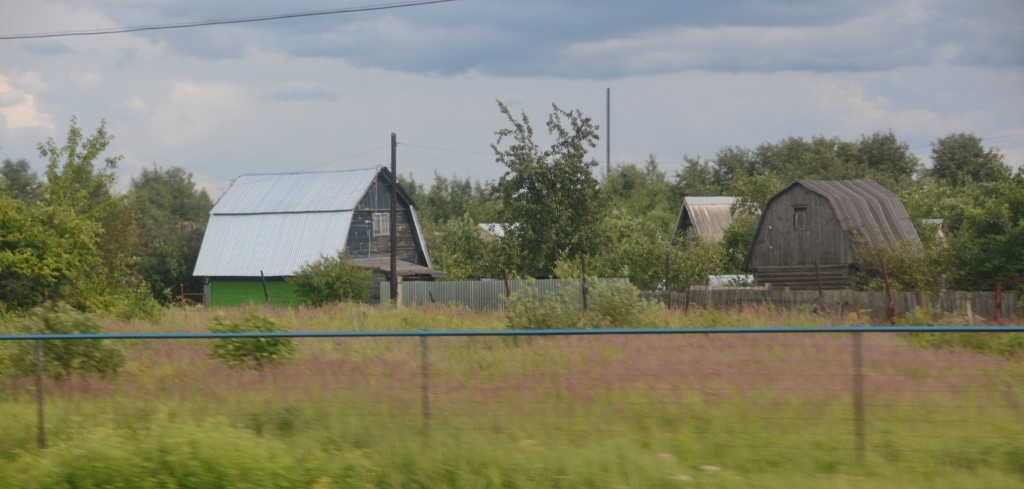

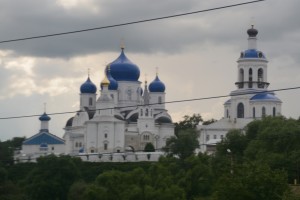


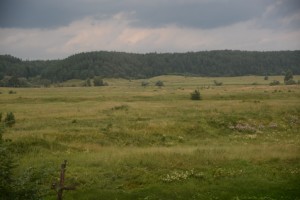


We spend time dozing, writing, reading, doing sudokus, gazing out the window and just generally relaxing. At the occasional stop, Roger races out to clean the windows – Whichever window is on the platform side gets a good clean.
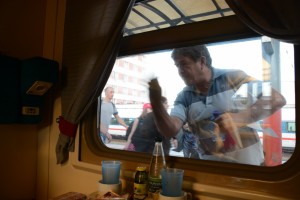
In the evening Wendy and Ash, a couple from England, and their three children pile into our cabin for a chat. They have trained from London (with a brief flight detour when they were deported from Belarus for not having the correct visa) and are travelling through to China, then on to Japan and eventually Thailand. We will get off in Ekaterinburg tomorrow but their first stop is not until Irkutsk some 50-odd hours later. They are very well-travelled and we enjoyed chatting for an hour or two while the sun set over the Volga river.
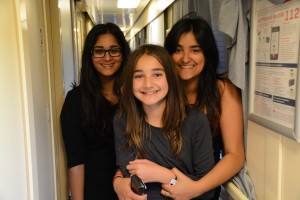


In second class, the cabins are the same but with four passengers and bunk beds. Having Wendy and Ash in the cabin with us for a while was great but I am very grateful for the extra space we have travelling on our own in first class. With extra luggage as well it must be fairly tight in those second class cabins.
Eventually the motion of the train rocks us to sleep for the night.
Roger:
Sunday 12 July
I am woken by the carriage rocking around on a bit of rough track. It’s broad daylight and a check of the clock tells me its 4am.
The countryside is much the same as yesterday. Large chimneys with their faded red and white paint mark huge rundown buildings, I presume once massive factories of the Soviet past. We have passed hundreds of these. Most houses visible from the train are rundown – mainly made of wood and asbestos roofing. They are still lived in with large piles of firewood stacked outside fuelling the thick grey smoke emerging from the small chimneys. It is 22 degrees C so I presume cooking is done on these fires. The green shrubs, occasional large untended fields and deciduous trees create a pretty scene. I can only ponder why this huge country with all the resources required to make a wealthy nation can look so run down and hard to live in.






Back in Moscow and St Petersburg cars came from Western Europe, Japan and Korea. Even the cars stopped at the rail crossings out here are not made in Russia.
26 hours and 1814 kilometres from Moscow we pull into Yekaterinburg. We say goodbye to the hostie who is full if smiles as she stands by the door on the platform. The bottle of vodka we gave her must have worked.
Outside the station we approach a taxi driver, a serious chap with a large motor leaning on his rather large Pontiac-like, Russian made car. Immediately another guy approached – “I speak English, I am just here to help”, then there were three of them seriously discussing our destination. Eventually the huge boot opened, our bags were in and we were on our way with Mr Serious. Paying the guy his rubles and taking a photo of his car finally got a smile.
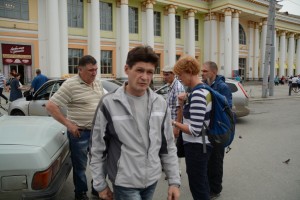
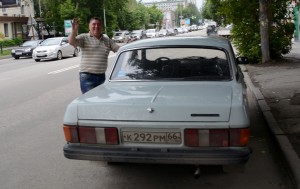
At first glance this is a rough hard town with hard-looking people trying hard to move into the 21st century. From what I have seen so far it looks like Lenin’s legacy has not been all that good for the people. I ponder what would have been if the reds hadn’t come into power.
We wandered less than a block from the hotel and found a huge, modern shopping mall still going strong at 8pm on Sunday evening. The contrast is amazing here. Three floors up we found a superbly decorated Kazan-style restaurant where the tucker had really nice, almost Middle Eastern, flavours and the staff were excellent, responding really well to communication by pointing.

Sylvia:
Monday 13 July
Today has been a fairly dreary, cold (by my standards anyway – Roger still coped in shorts and a t-shirt all day) and, at times, drizzly day. I think fairly apt for exploring this town.
Yekaterinburg was established in 1723 as an iron and copper industrial town. It has had a chequered history since then as the capitol of the Urals region, technically still 260kms outside of Siberia. In 1917 the Romanov family were murdered here after the revolution. The area became a major centre for defence-related industry during the Soviet era and was closed to foreigners during this time. Boris Yeltsin grew up in the area. Then in the 1990’s the town became infamous as a mafia centre and there were several high profile killings between the two rival gangs that lived in the area. Our time here has focused on exploring different facets of many of these things.
The staff at the hotel have been incredibly helpful and patient, trying very hard to understand our many requests and taking time to help us make arrangements to see different things. First up we had decided to go and visit the infamous Mafia Cemeteries where several of the mafia mentioned before were buried, complete with life-size granite etchings of themselves – the bosses in suits and the enforcers in leather jackets and loose trousers. This one generated a few giggles from the girls behind the reception desk but we managed to get it sorted. We were picked up by a taxi driver in his nearly new Lexus who drove us around and waited for us – for 2/3 the price we paid for our clapped out taxi to the hotel yesterday… I enjoyed ribbing Roger about that one – even though he says he knew we were “being stroked” yesterday.
It is quite astounding to see these full size etchings and at some of the graves even picnic tables and chairs for visitors. But back to the contrasts in Russia, despite the huge expense of the graves, the cemetery was really rough, particularly compared with some of the immaculate ones we have seen in other places this trip.
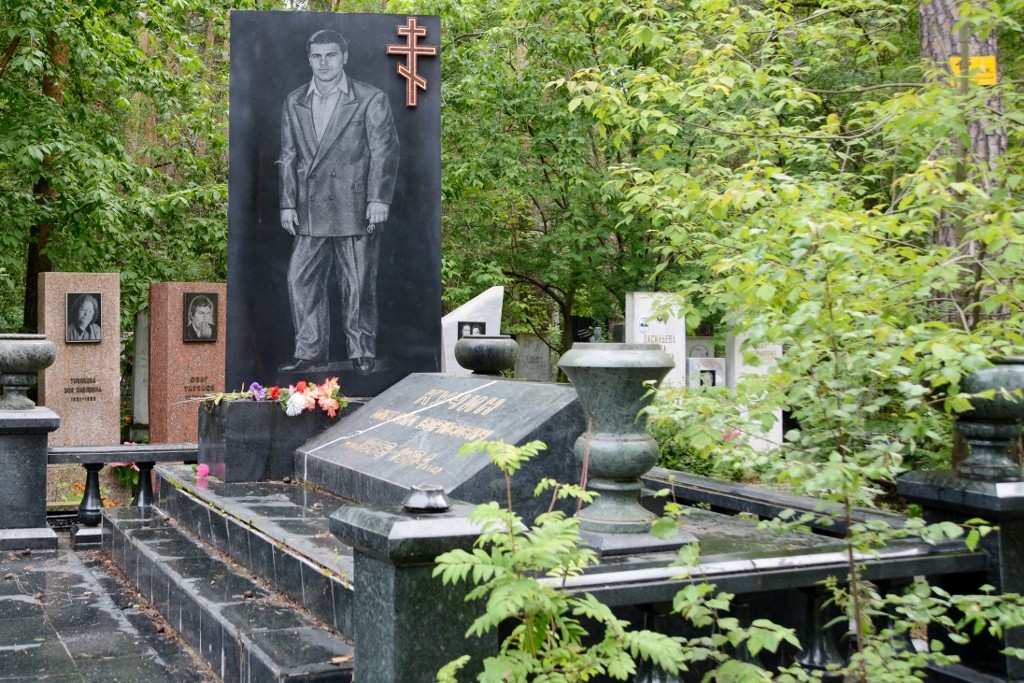


Right next door to the cemetery is the World War II memorial with some amazing etchings to commemorate Russia’s involvement in the war. I don’t think it matters which side you are on in any war, the human toll is still the same.
We headed back to the hotel and set off on a walking tour, first passing the Yekaterinburg Circus, and then a giant stone computer keyboard randomly placed alongside the river!?!?! We then headed to the 52nd floor of a large building which has been established as an observation deck overlooking the city. The views were quite incredible despite the howling wind. The city actually looks better planned and more modern from higher up.




Continuing along we stopped at the History of Yekaterinburg museum, built in some famous guy’s old house. Most of the exhibits were in Russian only but it was still remarkably interesting as there were lots of interactive maps and videos etc. One in particular was really impressive – a large book that when you turned the pages had different pictures projected on to it showing the city in the 1700’s, 1800’s and now. We even watched a couple of 3D movies about the place – with note cards provided in English.
Our next stop was the Church of the Spilled Blood, built on the spot where the Romanov’s were murdered. The guide there was incredibly lovely, showing us around and ensuring we had our pictures taken in the right places. The exhibits here were in Russian and English and, having first heard their story when I was a child, it was really interesting to get a sense of the time around their deaths and the senselessness of it all. In the basement there were a whole lot of exhibits about World War II as well.

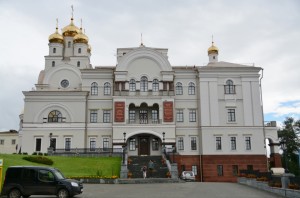

We wandered back through the city marvelling at the many monuments and quirky statues about. We even stopped briefly at a shopping mall where I was amused to see Roger being fawned over by three sales women and one salesman while he bought a couple of shirts. I think he quite enjoyed all the attention – perhaps it just took four of them to make sense of what he was saying – or was it just outstanding service?
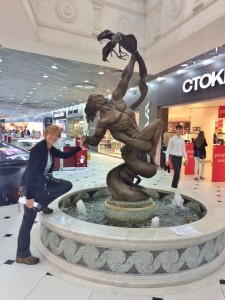

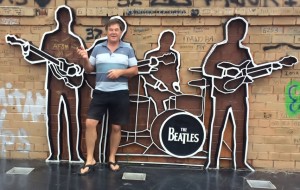
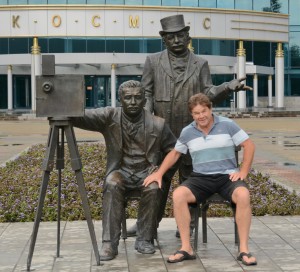
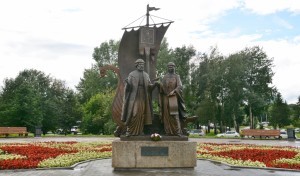
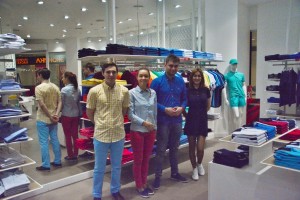
Roger:
Tuesday 14 July
We took a cab organised by the hotel heading north out of the city through the suburbs. It’s a pretty rough looking town. Like most eastern cities the road is very wide with two sets of tram tracks running along the overgrown grassy verge between the roads. The square box shape trams look very, very old – maybe 50’s era. Old looking apartments and other buildings turn into small wooden lace houses serviced by above ground gas mains as we get further out of the city.
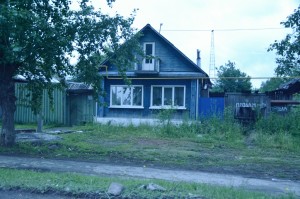
We are stunned on reaching our destination. The Museum of Military Technology is mainly outdoors. It is immaculate, the grounds clean, tidy and well laid out. There is a WWII monument at the entrance. Inside the gates are every tank, artillery piece, and rocket launcher used by the Russian Armies from 1939 through to 1990. There are also planes, trains, boats and much more. Probably our favourite was the fully armoured train. Unfortunately the indoor museum was closed. At a glance it looked like it contained a collection of old cars, small planes and, I presume, much more.
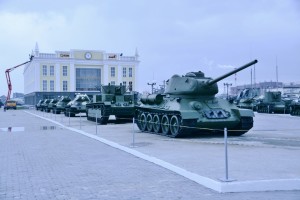
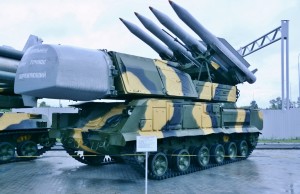


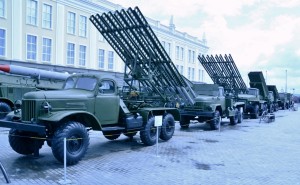


The same taxi later took us to the station; the fare in his Toyota was 250 locals. I knew the man with the big motor had ripped us off on the way to the hotel – 600 locals he charged us! I reckon taxi drivers all over the world must go to the same training school. I can never bring myself to trust the bastards.
Back on the train we head east to complete the 5153 kilometre journey to Irkutsk.
As we roll out of town passing again large disused factories and ramshackle houses the land flattens out. It’s really pretty country. Green prairies with clumps of silver birch type trees. Some of the unfenced fields are cultivated, others grow crops, and in places hay has been stacked in heaps on the fields. The odd village we pass has the same ramshackle small houses. Occasionally we pass a relatively modern factory that looks like it’s actually producing something.



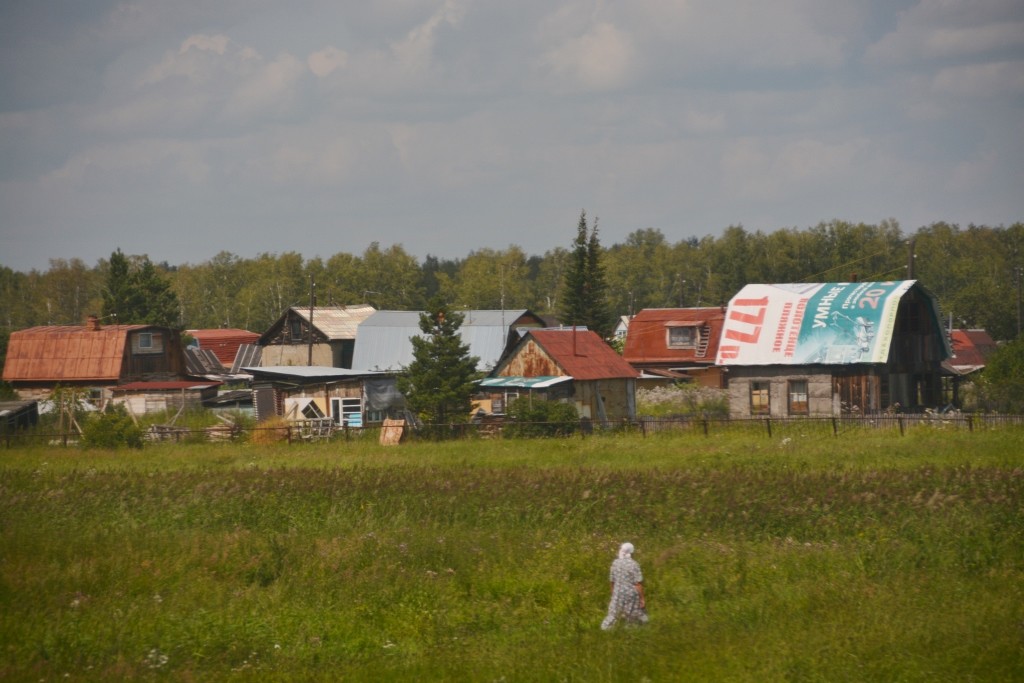
On the last leg our cabin was well prepared with cups, snacks etc. The friendly hostie chick gave us cards to lock the cabin. No such luck this time! The hostie is a big, strong, grumpy woman who looks like she used to pull trees for a living. Any questions receive the arms up in a cross, which we figure out pretty quick means no.
Back in 1975 my mother took this train from Vladivostok to Berlin – over 11,000km. She travelled on her own in a second-class carriage non-stop. I recall her saying the only happy looking people she saw were soldiers, of which there were lots. We have commented several times during this trip about how impressive it was for her to do this trip on her own, particularly back during the Soviet era.
Sylvia:
Wednesday 15 July
Our journey continued today in much the same fashion. We stop for 20 minutes or so a few times at stations like Omsk and Novosibirsk where we can stretch our legs and replenish our supplies.


Russia is a huge, vast country but so far the scenery has changed little. We have commented several times that it is pretty countryside – wide, flat fields with the odd stand of trees and cluster of houses. One of my enduring memories is likely to be the fields and fields of wild flowers, mostly purple and white, we pass along the way.

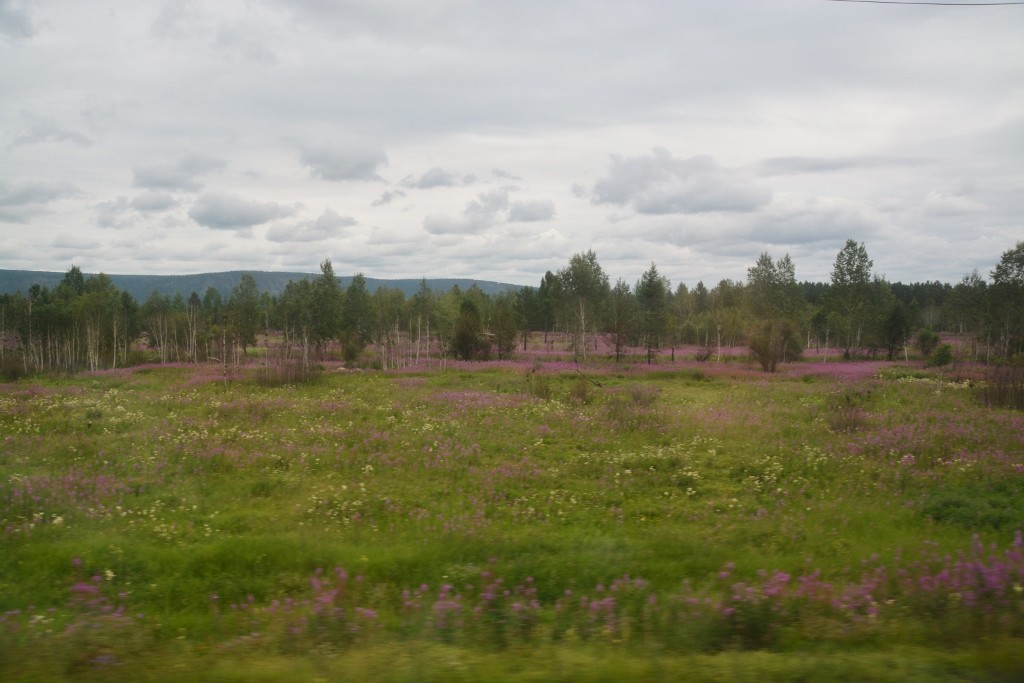
In our carriage are other tourists like us travelling through to Irkutsk or further, and the odd local who is as likely to stay on board only until the next station. It certainly keeps the hostie busy changing over the linens in the rooms.
Tonight Roger whipped up a gourmet dinner of 2-minute type noodles with a bottle of Chardonnay. I broke up the chocolate for dessert. Truly a testament to our cooking skills. At least we had managed to find a couple of forks today. Last night we had to slurp our noodles soup style. And in truth, it was probably better than breakfast. Roger went off hunter-gathering at one of our stops this morning and did a half-decent job: the okay half – a sausage in bread kind of thing; the not okay half, some super smelly fish things that we had to wrap up and discard as soon as we started opening them, and the smell was still lingering in the carriage some 30 minutes later. This, I think is all part of the training experience.
Roger:
Thursday 16 July
The first part of the day the country was similar to yesterday. Flat with areas of pine forest. Eventually we moved through some rolling, almost farm land, country but there was no sign of stock. We pass lots of freight trains. This after all is apparently the busiest rail freight corridor in the world. We pass thousands of cylinder like carts apparently carrying oil to Novosibirsk where it is exported via the Black sea.

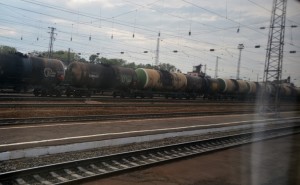


Interestingly since we entered Siberia we have not seen any gold domed churches.
We met a lady called Oksana who is traveling to Irkutsk. She is an economist and university lecturer from a city south of Moscow. She was explaining that when all the redundant factories were privatised in the 90s most went broke. They have now been replaced by smaller operations which are more competitive. When asked which was the better system she explained that a free economy has ups and downs whereas a managed economy has slow but steady growth. It would however take 120 years to prove which is better in the long run.
She also explained that the sanctions from the Ukraine debacle are good for the Russian economy allowing local manufactures to get traction in the market. About 30% of the cars we see on the road are actually manufactured in Russia.
As we close on Irkutsk 5153 Ks from Moscow we are starting to see more actual paddocks with a few cows and horses in. There are more signs of farming with huge recently harvested fields, even the odd paddock of hay bales. This is very rolling, picturesque country still dotted with ramshackle villages.

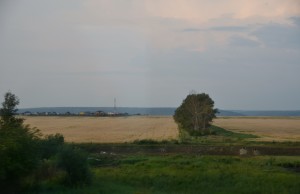


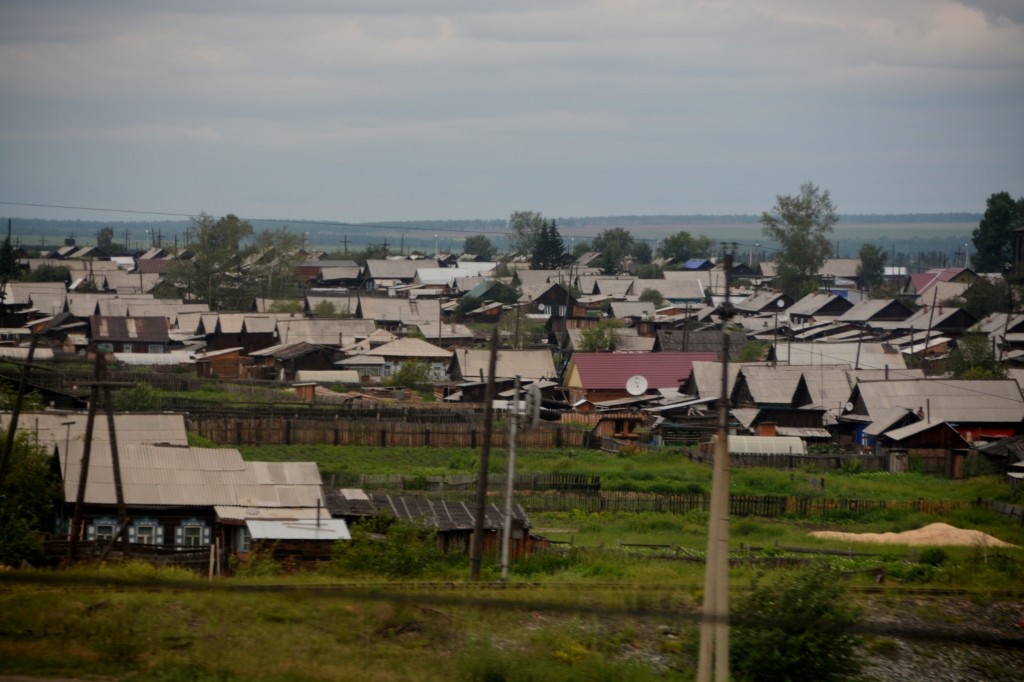

The trains run on Moscow time so as we approach Irkutsk at 1911 hours the clock in the carriage says 1412. We have moved through 5 time changes on this journey.
There are 9 cabins in this carriage. We have a couple from France, Fred and Fred; a couple from England, Imran and Sonali; a father and son, Gus and Daniel, from Ireland; and Oksana from Russia, all getting off in Irkutsk. Pablo, from Spain, is going non-stop all the way to Vladivostok.
We have had a few stops along the way, some just two to ten minutes, and a couple for thirty minutes when they change the engine and the tappers go along with their long-handled hammers and tap the wheels, springs and other bits, I presume detecting faults by sound. I thought these guys went out at the end of the steam days.
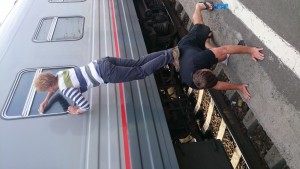
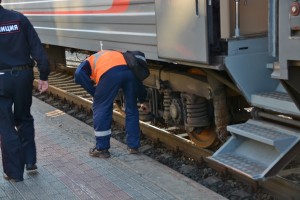
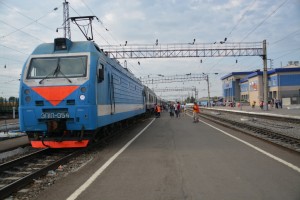

We passed a number of trains loaded with military vehicles and some LAVs.
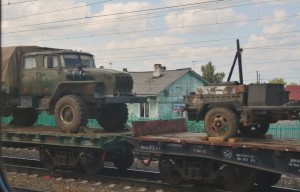

As we arrived in Irkutsk the grumpy hostie raced through each cabin taking sheets etc.
We headed out to the station entrance to await our pre ordered ride to the Hotel Kupechesky Dvor who eventually turned up after a couple of phone calls. The hotel is well located with lots of restaurants nearby, at one of which we enjoyed some very tasty venison dumplings.
